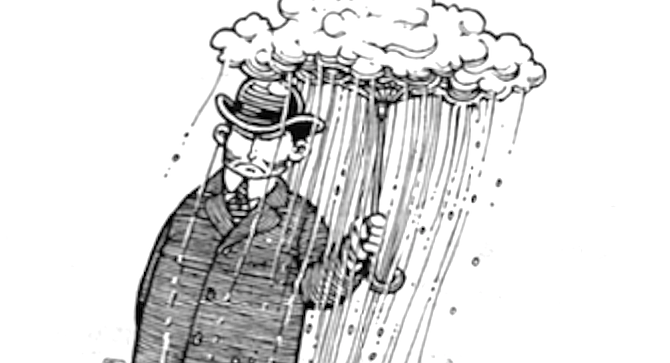 Facebook
Facebook
 X
X
 Instagram
Instagram
 TikTok
TikTok
 Youtube
Youtube

Dear Matthew: When a cloud is getting darker and darker, that’s because it’s filling up with water and getting ready to rain or snow. But if it needs a certain amount of water to make a big old raindrop, then why sometimes when it rains does it come down as a mist like it did recently? If it can come down as a mist, then why doesn’t it always do that instead of waiting, as it seems to, to get enough water for big full-on drops like we got the next day? — Handsome Jeff, at large
Hey, Jeff, can you stop doing those flex poses in the bathroom mirror and pay attention here? No, no, put down the brush and blow dryer for a minute. Thanks. I guess you stopped gazing at that GQ face long enough to at least stick your head out the door to see that a fine mist was falling. If so, then you probably noticed one other thing. When you resumed the contemplation of your finely chiseled features, you discovered that every expensively trimmed hair was still in place. It may have been raining, but there was no wind.
Wind is one of the keys to the drop-size puzzle. Mist and drizzle fall from stratus clouds. Those are the relatively thin, wide clouds that have no air turbulence or updrafts in them like storm clouds do. When the temperature is cool enough, water in the air condenses until the size of the drop is sufficient to allow it to fall. With no updrafts to overcome, the drops in mist and drizzle can be pretty tiny; officially they’re any drops smaller than .5mm in diameter. In storm clouds, these small drops bounce around on updrafts and downdrafts, bumping into each other and massing together into your big, full-on raindrops.
I don’t imagine you’re the Mr. Science Guy-type, Jeff, but if you were, you could make a device to measure the drops next time it rains. Take a pair of pantyhose (already worn or washed; probably find a few of those lying around the house from time to time, huh, Jeff?), stretch the hose part tight (an embroidery hoop will hold it well), then sprinkle powdered sugar over the surface and tap off the excess. Expose the stocking to rain, and each drop will leave a circular mark the diameter of the drop. Full-on, hard-hitting drops are usually shaped more like fat contact lenses than spheres — domed on the upper side, dented on the bottom from the air pressure during the fall. So their diameter isn’t a true spherical diameter. As if you care.... Okay, Jeff, back to the mirror. And study that hair a little more closely. Looks dangerously under-moussed.


Dear Matthew: When a cloud is getting darker and darker, that’s because it’s filling up with water and getting ready to rain or snow. But if it needs a certain amount of water to make a big old raindrop, then why sometimes when it rains does it come down as a mist like it did recently? If it can come down as a mist, then why doesn’t it always do that instead of waiting, as it seems to, to get enough water for big full-on drops like we got the next day? — Handsome Jeff, at large
Hey, Jeff, can you stop doing those flex poses in the bathroom mirror and pay attention here? No, no, put down the brush and blow dryer for a minute. Thanks. I guess you stopped gazing at that GQ face long enough to at least stick your head out the door to see that a fine mist was falling. If so, then you probably noticed one other thing. When you resumed the contemplation of your finely chiseled features, you discovered that every expensively trimmed hair was still in place. It may have been raining, but there was no wind.
Wind is one of the keys to the drop-size puzzle. Mist and drizzle fall from stratus clouds. Those are the relatively thin, wide clouds that have no air turbulence or updrafts in them like storm clouds do. When the temperature is cool enough, water in the air condenses until the size of the drop is sufficient to allow it to fall. With no updrafts to overcome, the drops in mist and drizzle can be pretty tiny; officially they’re any drops smaller than .5mm in diameter. In storm clouds, these small drops bounce around on updrafts and downdrafts, bumping into each other and massing together into your big, full-on raindrops.
I don’t imagine you’re the Mr. Science Guy-type, Jeff, but if you were, you could make a device to measure the drops next time it rains. Take a pair of pantyhose (already worn or washed; probably find a few of those lying around the house from time to time, huh, Jeff?), stretch the hose part tight (an embroidery hoop will hold it well), then sprinkle powdered sugar over the surface and tap off the excess. Expose the stocking to rain, and each drop will leave a circular mark the diameter of the drop. Full-on, hard-hitting drops are usually shaped more like fat contact lenses than spheres — domed on the upper side, dented on the bottom from the air pressure during the fall. So their diameter isn’t a true spherical diameter. As if you care.... Okay, Jeff, back to the mirror. And study that hair a little more closely. Looks dangerously under-moussed.
Comments